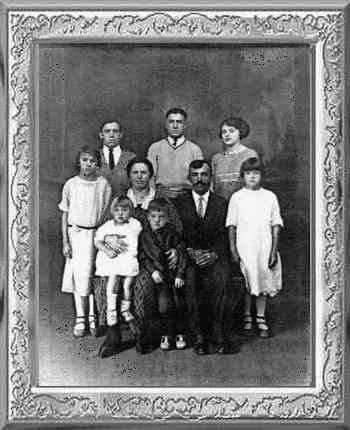| Home | Family Tree | Index | Wall of Honor | Links |
| Awards | Awards Rec | Guestbook | Webrings | Search |
 |  |  |
|---|

Tid Bits of Information
The Slama name in Slovenian means
straw or thatch.
in Serbian and Croation it means
straw, litter or stover.
Main Entry: sto暇er
Pronunciation: 'stO-ver
Function: noun
English 1 : FODDER
2 : mature cured stalks of grain with the ears
removed that are used as feed for livestock.
Heritage
The family says, we are of
German stock.
Physical Characteristics
In her youth
Grandma was a woman of great beauty,
she was between 5'2" and 5'4" tall,
she had blue eyes and thick brown hair
that she kept braided and coiled in
a bun at the nape of her neck.
As she aged, she got a little chunky
but was never considered fat.
Granddad was handsome also, (come to think of it,
because of this union, it must be
where I get my good looks ;-)
He was between 5'6" and 5'8," had
brown eyes and hair and a slim build.
Grandma's Kitchen
Krump und Nokle
(Potatoes and Noodles)
Sorry about the pronunciation and spelling,
that's as close as I can come.
There were two variations of this dish,
one was dry the other wet.
First she would fry course bread crumbs
in bacon fat until they were
brown and crispy. Then she would add
boiled cubed potatoes just until
they were heated through, not browned.
Next she would add precooked noodles
using the same method, salt and pepper.
The wet dish was a potato and noodle soup
without the crumbs.
My Mother said, Grandma could peel a potato
with the thinnest of skin in
the blink of an eye.
In the late Spring when canning
cherries, she would save back enough
cherries to make a liqueur.
She would cook the cherries in water,
add sugar to taste, drain them, fill the
jar and add Vodka. At Christmas time
the adults drank the liqueur, the
children were allowed a cherry or two.
Frankly that's all I wanted, too strong for me.
She also made cookies at Christmas. One that
I remember was a cookie made out
of a short bread dough.
The dough was patted on to a
cookie sheet that had sides
about 1/2 inch thick, next
was a layer of sweetened poppy seed mixture,
that was topped with a lattice of
the cookie dough.
Other fillings were raspberry, apricot
or some other equally delicious jam.
Steerage
So called because it was located on the lower decks where the steering mechanism of the sailing ships had once been housed.
Map As The Crow Flies
Take a tour of Osijek
Osijek Today
More Photos of Osijek
Croatian Personal Home Pages
Croatian History
Web Camera
World Time Zones
Background
We know very little about my Granddad
and Grandmother's life in the old country.
From what I can gather searching
the web, immigration was caused mostly
by economic, political, and social conditions in Croatia.
Years of poor harvest with their
food shortages, unpaid loans
and, in the maritime provinces, the decline
of such industries as wooden-ship building,
fishing, and wine-making,
in addition to the political neglect of the
region, triggered mass immigration.
In spite of its economic nature,
immigration was also political.
The Croatian politician, S. Radic, notes in his book
"Moderna kolonizacija i Slaveni"
(Modern Colonization and the Slavs)
that the reason for immigration is
"that somewhere in the world there is more good and justice" (Radic 1904).
(Some young men immigrated to avoid
the military, which was not the
case with Granddad, he served
his tour of duty.)
There were also other reasons for immigration,
the rapid industrial growth of certain
countries, especially the United States,
constantly attracted a new working force from underdeveloped countries.
Profession, occupation, sex, and age of immigrants statistical data show that over eighty-six percent of immigrants were peasants (Lakatos 1914).
In the beginning, immigration
didn't occur in family units.
In the first period of immigration
from Croatia to America there were
very few women among the immigrants.
During the era of mass immigration before
World War I, a great majority of the Croatian
immigrants were men.
People who intended to emigrate did
not normally have enough money
at home to pay for the voyage.
It was difficult to raise the fare and many
ended up borrowing from relatives
and friends who were in America already.
(We don't know if this was true
in Granddads case, although we do
know he lived with Uncle Julius in Pa.)
When enough money had been collected,
the women and children were sent for.
In the years before World War I
the percentage of women requesting
permits to immigrate increased.
They either set out to join their husbands,
or to get married in America.
In 1913, entire families in
ever-growing numbers started to immigrate.
Of the migrants of 1901 roughly
ten percent were women but by 1912
this figure had increased to
more than thirty percent.
Data were also collected about the
age of the immigrants.
According to age, the following percentage of
persons immigrated in the period
1900-1912: 25.8 percent were under twenty;
35.6 percent were between twenty and twenty-nine;
24.3 percent were between thirty and thirty-nine;
13.3 percent were between forty and forty-nine;
and 3 percent over fifty years of age (Lakatos 1914).
Granddad as near as I can calculate,
was 31 or 32 in 1912.
There is a translator at each site.
| Home | Family Tree | Index | Wall of Honor | Links |
| Awards | Awards Rec | Guestbook | Webrings | To the Top |
Page last updated: August 13, 2001